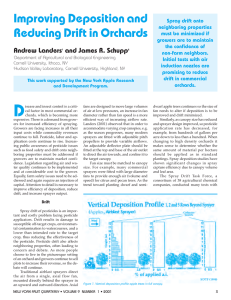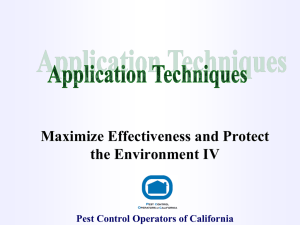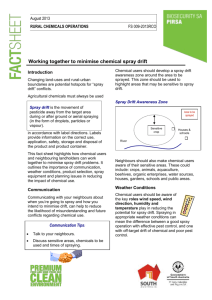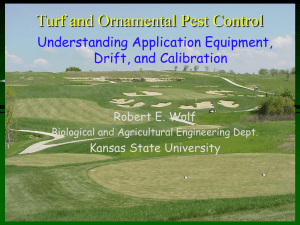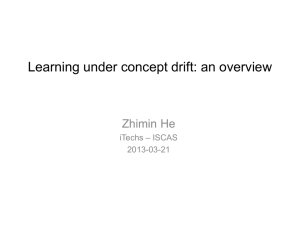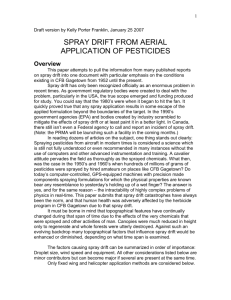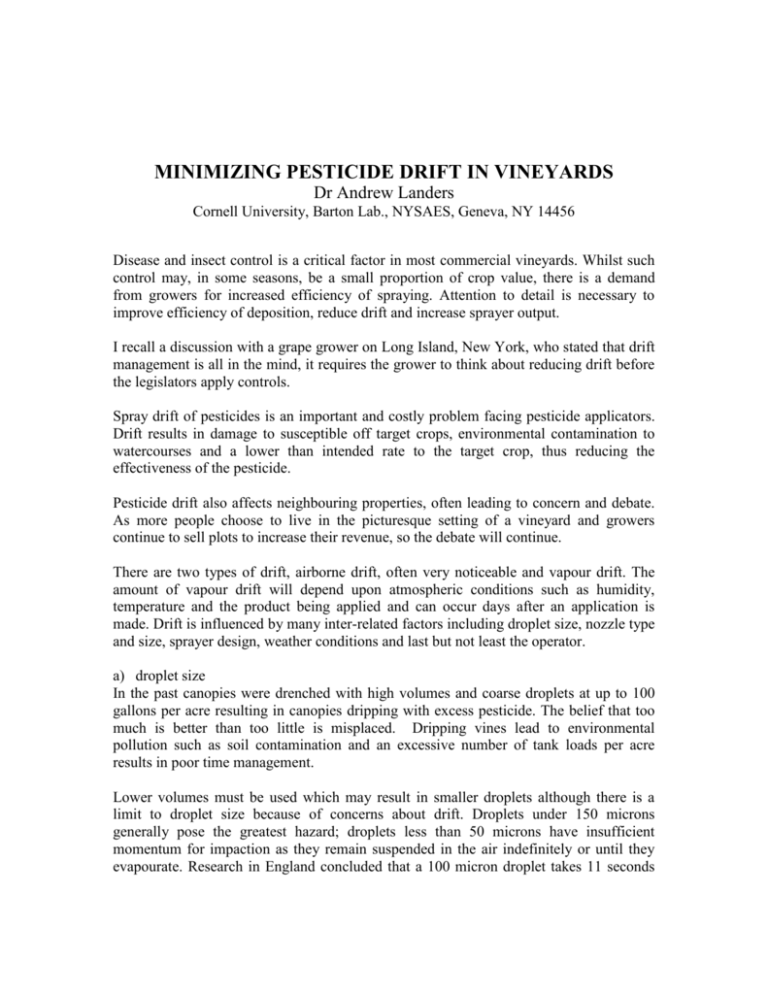
MINIMIZING PESTICIDE DRIFT IN VINEYARDS
Dr Andrew Landers
Cornell University, Barton Lab., NYSAES, Geneva, NY 14456
Disease and insect control is a critical factor in most commercial vineyards. Whilst such
control may, in some seasons, be a small proportion of crop value, there is a demand
from growers for increased efficiency of spraying. Attention to detail is necessary to
improve efficiency of deposition, reduce drift and increase sprayer output.
I recall a discussion with a grape grower on Long Island, New York, who stated that drift
management is all in the mind, it requires the grower to think about reducing drift before
the legislators apply controls.
Spray drift of pesticides is an important and costly problem facing pesticide applicators.
Drift results in damage to susceptible off target crops, environmental contamination to
watercourses and a lower than intended rate to the target crop, thus reducing the
effectiveness of the pesticide.
Pesticide drift also affects neighbouring properties, often leading to concern and debate.
As more people choose to live in the picturesque setting of a vineyard and growers
continue to sell plots to increase their revenue, so the debate will continue.
There are two types of drift, airborne drift, often very noticeable and vapour drift. The
amount of vapour drift will depend upon atmospheric conditions such as humidity,
temperature and the product being applied and can occur days after an application is
made. Drift is influenced by many inter-related factors including droplet size, nozzle type
and size, sprayer design, weather conditions and last but not least the operator.
a) droplet size
In the past canopies were drenched with high volumes and coarse droplets at up to 100
gallons per acre resulting in canopies dripping with excess pesticide. The belief that too
much is better than too little is misplaced. Dripping vines lead to environmental
pollution such as soil contamination and an excessive number of tank loads per acre
results in poor time management.
Lower volumes must be used which may result in smaller droplets although there is a
limit to droplet size because of concerns about drift. Droplets under 150 microns
generally pose the greatest hazard; droplets less than 50 microns have insufficient
momentum for impaction as they remain suspended in the air indefinitely or until they
evapourate. Research in England concluded that a 100 micron droplet takes 11 seconds
approximately to fall ten feet in still air; when a similar size droplet is released into a
5mph wind it will drift about 75 feet before hitting the ground.
The higher the operating the pressure, the smaller the droplet, conversely, low pressure
produces large droplets that may bounce off the target. Traditional air blast sprayers give
the greatest cause for concern as they produce many small droplets which are often offtarget. Certain spray surfactants can change the droplet spectrum, reducing the number of
driftable droplets.
b) nozzle type and size
Modern nozzle technology such as air inclusion nozzles produce larger droplets than
conventional cone nozzles. Large droplets normally roll off the leaf but air inclusion
nozzles create air bubbles within the larger droplets which then collapse on contact with
the leaf, dissipating the energy and dispersing the liquid. Recent research in England and
Germany has shown promising results using air inclusion nozzles with air blast sprayers
in trees and bushes although further trials are necessary in vineyards.
Rotary atomisers create smaller, more uniform droplets, which would normally drift.
When used in conjunction with a tower and cross flow fan design the smaller droplets are
actually directed into the canopy. This type of sprayer, referred to by some as controlled
droplet application, produces 95-98% of its droplets all of the same size. The size
produced depends on the speed of the spinning cage. Advantages include less water,
resulting in better timeliness and a more targeted spray.
c) sprayer design
Tower sprayers and tunnel sprayers are better at targeting the spray into the canopy,
reducing drift and increasing deposition. The conventional air blast sprayer sends droplets
in an air blast from a central fan upwards into the canopy. Horizontal penetration into the
canopy is preferential to vertical penetration from an air blast sprayer. Tunnel sprayers,
developed many years ago in Europe and the USA, have tremendous advantages in
vineyards. The use of a spray collection device at the base of the tunnel canopy results in
the ability to recirculate spray with subsequent savings in pesticide and a reduction in
drift. Many growers believe that tunnel sprayers are only suitable for level land but an
increasing number are to be found in vineyards on undulating land such as in the Finger
Lakes region.
Drift problems increase when a space occurs within the row. Air blast sprayers, with or
without a tower, can be fitted with ultrasonic or laser canopy sensors. The sensors also
detect the shape of a canopy and adjust the spray pattern accordingly. The advantages
include reduced drift and ground deposition, reduced pesticide use and improved
logistics.
Current extension activities via Cornell University and Penn State University include
regional demonstrations of directed deposition sprayers, machines which direct the spray
into the canopy rather than blast the spray upwards into the atmosphere.
Current research at Cornell University involves investigating methods of reducing drift
from conventional air blast sprayers, as they are the most commonly used sprayers in
vineyards in New York State.
Herbicide drift from weed control practices should not be forgotten, shielded herbicide
sprayers prevent drift from contaminating grapes and damaging leaves. Shields can vary
from the simple to the complex, fitted with flat fan nozzles or controlled droplet
applicators using reduced herbicide rates. Shielded sprayers allow growers to apply
herbicides in variable weather conditions. Great success in reducing drift has been found
when using air inclusion nozzles to apply herbicides in western New York.
d) sprayer calibration
Correct calibration will ensure that all the nozzles are discharging the correct amount of
liquid at the correct distance and angle to the target and at the correct forward speed.
Operators must set the air deflectors correctly to confine airflow, spray and disturbance to
the canopy.
e) weather
Wind speed and direction, relative humidity, temperature and atmospheric stability
affects drift. Applying the correct product to the correct target at the correct time with the
correct equipment is the key to good spraying.
Research in England and New Zealand has been conducted to measure the effectiveness
of shelterbelts. Natural and artificial belts were used and drift is reduced the closer you
are to the shelterbelt. Shelter belt height and density will affect drift, and may, in certain
conditions, create additional air currents and eddies. There are so many variables such as
topography and wind direction that it is difficult to conclude that research at one site is
transferable to another. It is worth noting that German growers face Federal drift
measuring programs to ensure a safe buffer zone of up to 150 feet resulting in severe
restrictions for some growers.
Choose the correct size sprayer with good back-up support to ensure that spraying may be
done in a timely manner. Far too often growers are racing around vineyards in an attempt
to apply pesticides after a problem disease or insect attack has occurred. Good logistical
support in reducing the need to return for frequent refills is so important. The use of field
cards, detailing the block, pesticide required, application rate, quantity required per tank
fill etc. will reduce stress levels found amongst some applicators. Integrated Pest
Management should also be considered. “Forward planning is the key to good
management”; a phrase often used by successful business managers also applies to
vineyard management.
Continuing development of spray application techniques will improve the efficiency of
vineyard spraying. Many of the factors which affect application and drift are
interdependent. Airflows must be optimised particularly where smaller droplets are used;
crop canopies and water volumes must be carefully considered if growers are to take
advantage of new technologies. Investment levels in modern technology must be
maintained if the grower is to remain competitive.
Management strategies to reduce drift
Before spraying:
1. Train the operator to use the sprayer correctly on your farm under your conditions.
2. Plan the spraying operation; consider the use of orchard field cards as a good
management tool.
3. Read and follow the pesticide label.
4. Select the correct nozzle for the target. Adjust the size and position of the nozzles to
achieve correct distribution within the canopy, particularly as the growing season
progresses.
5. Consider the use of sprayers which direct the spray to the target such as towers and
tunnels. Check that air deflectors are set properly to confine disturbance to the target.
6. Consider spray additives to reduce drift.
7. Improve spraying logistics to ensure adequate time to spray within ‘ideal’ conditions.
8. Only spray when weather conditions are ideal; avoid spraying on days when
conditions are favourable for atmospheric inversion or wind drift.
9. Calibrate the sprayer with water to ensure that everything is working correctly.
10. Start planting windbreaks!
During spraying:
11. Stay alert: ensure the spray is not allowed to drift on to non-target areas and watch for
changes in wind speed and direction.
12. Keep spray pressure as low as possible and ensure an accurate gauge is used.
13. Maintain a constant speed and pressure, if an automatic regulator is fitted, remember,
small increases in speed result in large increases in pressure. The delivered air and spray
must be given time to penetrate the canopy.
14. Avoid spraying near sensitive crops or water courses; use a 50 –100 feet buffer zone
Spray inwards, with one side of the sprayer, for at least 50 feet from the boundary to
create a ‘headland’.
© copyright. Cornell University, May 2000. All rights reserved.

